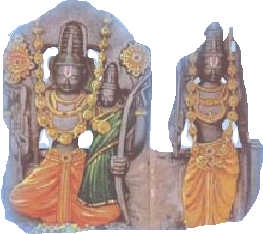Language Panel to bring out monthly bulletin


KAUSALYA SANTHANAM
| The palace of the former rulers of Ramanathapuram still displays vestiges of regal splendour. |
LIKE dusty sentinels, petty shops crowd the archway to the palace of the former rulers of Ramanathapuram, the Sethupathys. Few, even within this sun-lashed town know that this faded arch leads to buildings that contain some of the most exquisite murals in this part of the country. No other palace in Tamil Nadu has such extensive secular paintings, according to experts. As soon as you enter the freshly colour-washed Mahamandapam, you are surrounded by murals that glint like gem- encrusted jewels on the walls. Some are dull and faded while others flash forth their brilliance even 300 years after they were executed, mostly in the Telugu style of the Nayaks who held sway over the neighbouring large kingdom of Madurai.
In 1978, Ramanatha Sethupathy voluntarily handed over the Ramalinga Vilasam to the Tamil Nadu State Archaeology Department, which conserved and restored portions of it recently.
Range of themes
The paintings cover a staggering range of themes — the epics, Puranas, wars, royal assemblies and romance — and also reflect the Mughal influence. The rotund figures are attired in variously patterned garments and heavy jewellery, both in the traditional and Mughal style while the inscriptions in Telugu and Tamil give details about the panels. The rough block of stone one sees here is the coronation seat of the rulers of Ramanathapuram, similar to the Stone of Scone, the coronation seat of the kings of Scotland. The Sethupathys were protectors of the sacred island of Rameswaram.
A short flight of stairs takes one to the Durbar portion. The ceiling of this hall is covered with a breathtaking array of scenes and floral and geometric motifs. There is such variety and richness here that you wander through the room with constantly upraised head. There are scenes of playful amour and dalliance and of dance recitals and royal sports. Especially interesting is the panel that show Europeans offering gifts and saluting the king. The murals were executed during the reign of Muthu Vijayaragunatha Sethupathy (1710-1725), who figures often in the panels and is seen in one being adorned with gems by the Nayak of Madurai.
Narrow stairs lead to the bedchamber of the Sethupathys. All the frescoes have been restored in this room though some seem over bright.Here there is an unabashed sexuality in the depiction of some of the figures and an inventiveness in the manner in which some of them are fashioned. Most ingenious are those in the Deccani mode, of horses and elephants comprised of women in various poses.
It was in this chamber that the English Collector Jackson is said to have met the great chieftain Veerapandiya Kattabomman of Panchalankurichi, one of the earliest freedom fighters who rebelled against the British yoke.
The palace complex has a cluster of buildings in various stages of maintenance. The chief among them is the temple of Sri Rajarajeswari, the tutelary deity of the rulers. The sovereign of Madurai, Tirumalai Nayak gifted the golden idol to the Sethupathys. The temple has just closed but the white bearded, third generation priest allows you to have a glimpse of the deity through a chink in the door.
Among the rulers of Ramnad, Bhaskara Sethupathy was famed for his munificence and religious activities. It was he who encouraged Swami Vivekananda to visit Chicago to participate in the Parliament of World Religions. As we leave the main building a convoy of cars rushes in . Uma Bharti is on her "Bharat bachao" yatra and has just stepped into the Vivekananda Bhaskara hall within the palace premises to lay flowers at the portraits of Sri Ramakrishna Paramahamsa and Sarada Devi.
Portraits and arms of the rulers are displayed at the Ramalinga Vilasam, which is open to visitors at a nominal fee.
As with most minor or major princely houses, disputes about property affect the Ramnad family. Claimants to the Government pension include the descendants of the "rebel" king Muthuramalinga Sethupathy who courageously raised his voice and might against the British, and was deposed in 1795.
The heiress is now Rajeswari Nachiyar, the only offspring of the late Ramanatha Sethupathy and Indira devi. The simple and unassuming rani, who is hereditary trustee of numerous temples, lives in Chennai with her engineer husband and two children. Her cousin Kumaran and his wife have recreated a sort of aristocratic splendour in their high vaulted portion of the palace and run a school in the former zenana. As one goes though the many pillared zenana and sees "Play time" and "UKG" written on the walls, one feels yet again how past and present co-exist, often incongruously, as former Zamindars and royals make an attempt to find their place in contemporary times.
History of the Sethupathys
THE Sethupathys claim an ancient lineage. But the line can be clearly traced from the 17th century Hailing from the Maravar clan, they were hereditary chieftains who enjoyed a fair degree of independence from the suzerainty of the Pandya and Nayak kings.
Among the distinguished rulers were Thirumala Sethupathy who united and expanded the territories, Kilavan Sethupathy who constructed Ramalingavilasam and Muthu Vijayaraghunatha Sethupathy. Ramanathapuram was reduced to a zamindari by the East India Company in 1803.
Shanmugha Rajeswara Sethupathy was a minister in Rajagopalachari's cabinet. The Sethupathys patronised the arts and some of the rulers were writers of merit.
Source: District Gazette
Courtesy: The Hindu
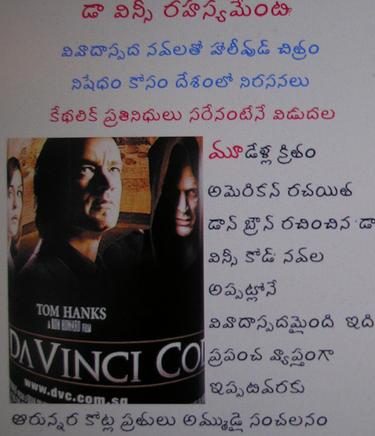
The film was originally scheduled to be released in seven theatres in the city in English and Hindi version on June 2 before it was banned by the State government. B. Subrahmanyam, proprietor of Lakshmi Ganapati Films, the controversy had given the film a “more publicity than we could have managed.” he said.
Courtesy: Deccan Chronicle
'డావిన్సీ కోడ్' నిషేధం చెల్లదు
హైదరాబాద్, జూన్ 21 (ఆన్లైన్): ప్రపంచవ్యాప్తంగా వివాదాస్పదమైన సినిమాగా పేరు తెచ్చుకున్న 'ది డావిన్సీ కోడ్ 'ను రాష్ట్రంలో నిషేధిస్తూ ప్రభుత్వం జారీ చేసిన ఉత్తర్వులను రాష్ట్ర హైకోర్టు కొట్టివేసింది. సినిమాను చూడకుండా.. ఎవరో నలుగురు వ్యక్తులు ఇచ్చిన వినతి పత్రాలను పరిగణనలోకి తీసుకుని ఈ విధంగా ఉత్తర్వులు ఇవ్వడం సరికాదంటూ ప్రభుత్వానికి హైకోర్టు చీవాట్లు పెట్టింది.
ది డావిన్సీ కోడ్ సినిమా ప్రదర్శనను రాష్ట్రంలో నిషేధిస్తూ జారీచేసిన ఉత్తర్వులను సవా లు చేస్తూ లక్ష్మిగణేశ్ ఫిలిమ్స్, ఆర్.కె ఫిలిమ్స్, సోని ఎంటర్టైన్మెంట్ ఇండియాలతో పాటు మునిశేఖర్రెడ్డి అనే వ్యక్తి దాఖలు చేసిన వ్యాజ్యాల్లో హైకోర్టు న్యాయమూర్తి జస్టిస్ గోడా రఘురాం బుధవారం తీర్పునిచ్చా రు. రాజ్యాంగం ద్వారా సంక్రమించి న హక్కులకు భంగం కలిగించే విధంగా ప్రభుత్వం వ్యవహరించినం దున ప్రభుత్వానికి హైకోర్టు పదివేల రూపాయల జరిమానా విధించింది.
Courtesy: ఆంధ్ర జ్యోతి
Authorities criticised
Mr. Justice Raghu Ram said the authorities who passed the ban order had not even seen the film. The officer "mechanically certified" the veto of a few objectors rather than arriving at a decision based on informed satisfaction. This was "arbitrary, casual and [a] wholly irrational exercise of a very sensitive and responsible executive power, namely the regulation of a cherished, valued and guaranteed fundamental freedom of expression."
The judge, who saw the film at a special screening, recalled various works on different interpretations of Jesus Christ.
The court said, "Freedom of speech and expression contributes to the richness and equilibrium of human existence." Terming the Government's action wholly negligent and an irresponsible exercise of executive power, the judge directed the Government to pay Rs. 10,000 each to the distributors and Rs. 2,500 to Mr. Reddy.
Courtesy: The Hindu
With a visit from Cayman Islands today, this blog has now been visited by people from 100 countries so far.
Micky Aigner
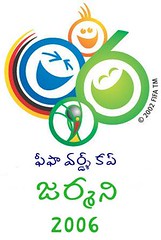 PUNE, JUNE 18:They aren’t celebrating in Vishakhapatnam yet but maybe they will in a few weeks, when Vikash Dhorasoo’s international career finally gets set to take off. The French midfielder has so long lived in the shadows of Zinedine Zidane—they play the same role for the French team—but Zizou’s retirement after the World Cup opens the way for him.
PUNE, JUNE 18:They aren’t celebrating in Vishakhapatnam yet but maybe they will in a few weeks, when Vikash Dhorasoo’s international career finally gets set to take off. The French midfielder has so long lived in the shadows of Zinedine Zidane—they play the same role for the French team—but Zizou’s retirement after the World Cup opens the way for him.
In fact, he’s already created history, becoming the first footballer of Indian origin to play at this level by turning out against Switzerland last week. ‘‘He told me it was a very special feeling,’’ his mother Nalinee told The Indian Express from Paris, where the family lives.
Though Dhorasoo himself has never spoken too emphatically about his Indian roots, saying only that he would like to go to India but ‘‘not as a tourist,’’ his mother had no such qualms. ‘‘We originally come from V-sha-ka-pat-nam,’’ she said, spelling out the word with a heavy French accent. ‘‘My grandparents lived in Andhra Pradesh.’’ They were taken to Mauritius to work on the sugar plantations, and that’s where Nalinee met Vikash’s father Manduth who worked as a plumber on the Britannia Sugar Estate.
The family moved to France in 1970, where Vikash was born three years later. His childhood was spent in Le Havre, Normandy, and he grew up in a neighbourhood called Caucriauville where he learnt the sport on the spaces available between buildings. ‘‘He was, I think, about nine when he went to play organised football, though studies was equally important,’’ Nalinee said.His steady rise through the ranks, with Lyon, Bordeaux, AC Milan and now Paris St-Germain, not only brought him to national attention but also dispelled the notion that Indians are genetically not predisposed to football at the top levels.
‘‘He is a good boy,’’ says legendary French coach Guy Roux. ‘‘His technique is very good, his passing is beautiful. Not that good in defence but his attacking skills are good.’’
Roux was coach at Auxerre for 44 years before retiring last July, taking the club from the regional Burgundy league to being French champions and his famous academy producing stars such as Eric Cantona and Djibril Cisse. Dhorasoo might have been another. ‘‘He was in my office in Auxerre as a young boy,’’ Roux said. ‘‘He spent two hours with me. We tried to sign him but he didn’t join.’’
What does he see in Dhorasoo’s future? ‘‘Unfortunately, I don’t think he’ll play that long for France because he’s 32; if he was 22, that would be different, he would have a long international career ahead of him.’’ Was he unlucky in being around the same time as Zidane? ‘‘Perhaps,’’ he says with a shrug.
Was football on his mind right through? ‘‘It’s in the family... his father’s side. In fact, both his father and uncle played football.’’ While Manduth played a role in shaping his football career, perhaps the greater influence came from his maternal uncle, Sama Sanassee. Speaking from Port Louis, Mauritius, Sama sought to downplay his contribution. “Ah! I was no professional like Vikash, you know. I played for a village called Lasalines in Port Louis as a youngster, nothing more.”
Yet Dhorasoo’s World Cup debut against Switzerland last week was celebrated in Mauritius (and, on the Net, by Telugus and Mauritians everywhere).
‘‘He made us all proud,’’ said Vanishree, Sama’s daughter. ‘‘We knew he was talented since he was associated with big clubs, it was only a question of when he would hold centrestage. A debut—even if for a limited period—in the World Cup almost makes us feel like we are part of Vikash’s biggest dream.’’
Has she spoken to him? ‘‘No, I haven’t but my dad (Sama) spoke to his dad (Manduth). They congratulated each other, after all it was a family thing, you know.’’
Vikash last visited Mauritius two years ago, Sama recalls. ‘‘It was a time when most of us Sanassees got together.”
Was he interested in his roots? ‘‘The interest to know his family roots is a common feature in these reunions,’’ Sama says.
So what is Vikash: French, Mauritian or Indian? “Vikash was born in France,” Sama begins.
‘‘He’s married a French girl,’’ he says after a pause. ‘‘It’s like his mother (Nalinee) who hails from an Indian family... all of us speak and understand Telugu, but were born in Mauritius.”
In football’s flat world, perhaps it really doesn’t matter.
micky.aigner@expressindia.com
Tirupati | June 19, 2006 5:40:33 AM IST
 France's first game in the FIFA World Cup Soccer 2006 with Switzerland: Vikash Dhorasoo came in the 82nd minute and almost scored an exciting goal - a sizzling shot from range which just missed the far post. It was probably the only hopeful moment from the otherwise uninspiring match it was till then.
France's first game in the FIFA World Cup Soccer 2006 with Switzerland: Vikash Dhorasoo came in the 82nd minute and almost scored an exciting goal - a sizzling shot from range which just missed the far post. It was probably the only hopeful moment from the otherwise uninspiring match it was till then.
NT Bureau
Chennai, June 12:
World Telugu Federation (WTF) will conduct free Telugu classes on every Fridays and Saturdays from 30 June. The classes would be held at WTF office, Anukur Plaza and at Sri V Ramakrishna Higher Secondary School, Thiruvottiyur, from 4.30 pm to 5.30 pm.
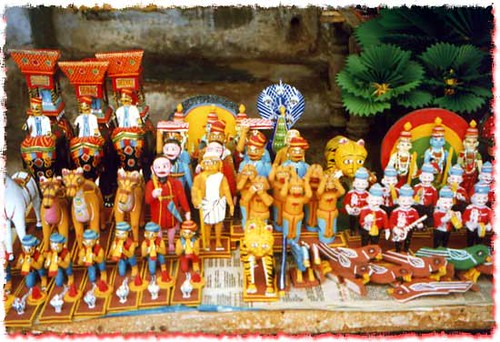 VIJAYAWADA: At a time when persons engaged in traditional occupations are dwindling, the number of artisans of Kondapalli toys are increasing.
VIJAYAWADA: At a time when persons engaged in traditional occupations are dwindling, the number of artisans of Kondapalli toys are increasing.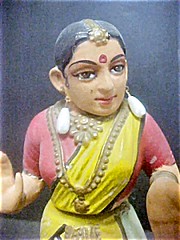 Likewise, the incomes all of the 60 families traditionally engaged in toy making have increased with difference of degrees. In each of these households, the man makes the toys and the women and children paint them.
Likewise, the incomes all of the 60 families traditionally engaged in toy making have increased with difference of degrees. In each of these households, the man makes the toys and the women and children paint them.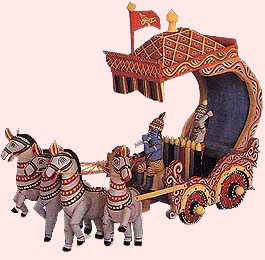
AMBIKA ANANTH
ILLALI MUCCHHATLU: Puranam Sita; Navodaya Book Distributors, 3-3-859/1/A, I Floor, Kachiguda, Hyderabad-500027. Rs. 150.
THIS BOOK is collection of essays published in the popular weekly "Andhra Jyothi" for three full decades, starting from 1960 to 1990, under the same title "Illali Mucchhatlu". This column was highly appreciated not only by common readers, but also by many literary stalwarts like Naarla Venkateshwara Rao, Nanduri Rammohana Rao, Ra.Vi. Shastri and Kodavaganti Kutumbarao.
Hand picked and chosen carefully from the whole lot to make a `string of pearls', these essays are endearing and educative. It is more like sharing juicy tidbits with a friend, not the usual gossip that idling and nitpicking housewives indulge in. In the garb of a woman, here one finds the `talk' by the author, a man, giving a funny and fresh and perspective on many common issues.
The great success of these essays is because they tickle sensations without hurting sensibilities.
A must read book, an indispensable book this one.
Courtesy: The Hindu

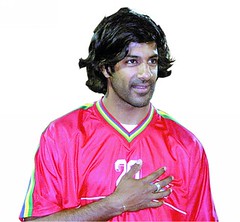 వికాష్ ధొరసూ
వికాష్ ధొరసూ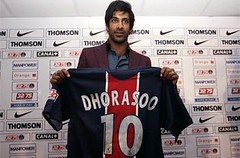 The father worked as a plumber in shipyards. Today, Vironi has a degree in psychology and is a professor, Vipin has entered management, while Vishna has succeeded in languages. Vikash joined university to study economics, before committing himself to professional football. At the age of nineteen, he signed the contract for Le Havre football club. "Jusqu’au jour de ma signature, je n’ai jamais été vraiment sûr que je ferais du football mon métier. " ( Until the day of signature, i was never really sure about taking football as profession), says Vikash.
The father worked as a plumber in shipyards. Today, Vironi has a degree in psychology and is a professor, Vipin has entered management, while Vishna has succeeded in languages. Vikash joined university to study economics, before committing himself to professional football. At the age of nineteen, he signed the contract for Le Havre football club. "Jusqu’au jour de ma signature, je n’ai jamais été vraiment sûr que je ferais du football mon métier. " ( Until the day of signature, i was never really sure about taking football as profession), says Vikash.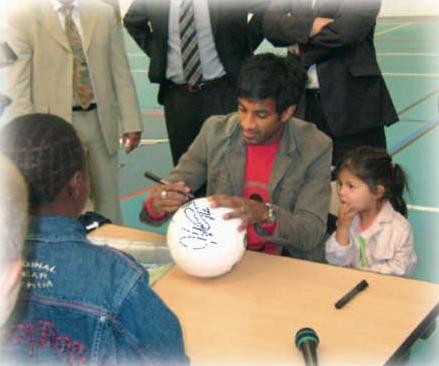
Vikash Dhorasoo, milieu de terrain de Lyon, dont les origines se situent au Havre, à l’île Maurice et en Inde, fera peut-être ses débuts avec l’équipe de France demain face à l’Ukraine.
Il ne parle pas l’hindi de ses parents mais le langage de Caucriauville, quartier populaire havrais. Dhorasoo vient d’intégrer le groupe des Bleus champions du monde.
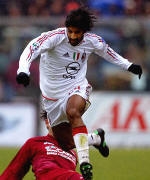 Son prénom signifie " progrès et prospérité ". Il se définit comme quelqu’un de " calme ", " tolérant ", " sage ". " Ça, c’est mon côté indien, dit-il. Pour le reste, mes racines sont au Havre. " Vikash Dhorasoo est né en France en 1973. Ses parents avaient débarqué deux ans plus tôt à Caucriauville, quartier populaire havrais. Ils venaient de l’île Maurice avec leurs trois premiers enfants. Le père fut embauché comme plombier sur les chantiers navals. Aujourd’hui, son frère Vipin possède une maîtrise de gestion, sa sour Vironi, après un DEA de psychologie, est devenue professeur des écoles et sa seconde sour, Vishna, a réussi une licence de langues. Seul Vikash a abandonné la fac dès la première année en science économique. " L’ambiance me plaisait pourtant ", dit-il. Mais il avait un mot d’excuse en forme de contrat professionnel signé à dix-neuf ans au sein du club de football du Havre. " Jusqu’au jour de ma signature, je n’ai jamais été vraiment sûr que je ferais du football mon métier. "
Son prénom signifie " progrès et prospérité ". Il se définit comme quelqu’un de " calme ", " tolérant ", " sage ". " Ça, c’est mon côté indien, dit-il. Pour le reste, mes racines sont au Havre. " Vikash Dhorasoo est né en France en 1973. Ses parents avaient débarqué deux ans plus tôt à Caucriauville, quartier populaire havrais. Ils venaient de l’île Maurice avec leurs trois premiers enfants. Le père fut embauché comme plombier sur les chantiers navals. Aujourd’hui, son frère Vipin possède une maîtrise de gestion, sa sour Vironi, après un DEA de psychologie, est devenue professeur des écoles et sa seconde sour, Vishna, a réussi une licence de langues. Seul Vikash a abandonné la fac dès la première année en science économique. " L’ambiance me plaisait pourtant ", dit-il. Mais il avait un mot d’excuse en forme de contrat professionnel signé à dix-neuf ans au sein du club de football du Havre. " Jusqu’au jour de ma signature, je n’ai jamais été vraiment sûr que je ferais du football mon métier. "
Vikash doute de lui, ou plutôt s’efforce de ne pas attraper la " grosse tête " - "de toute façon, mon entourage me corrigerait vite ", précise-t-il -, ce qui fait dire à tous les techniciens du ballon rond que sa marge de progression, à vingt-cinq ans, est encore très importante. Il confirme, mais il fait de la patience l’un de ses nombreux traits de caractère, probablement issu de l’héritage culturel familial. De la même manière, on lui reproche de ne pas être assez égoïste devant le but adverse. " Je le sais, répond-il en frottant mécaniquement une barbe de trois jours, mais je crois toujours que l’on peut encore faire une dernière passe alors que c’est parfois impossible. Moi j’aime donner sur un terrain de football. "
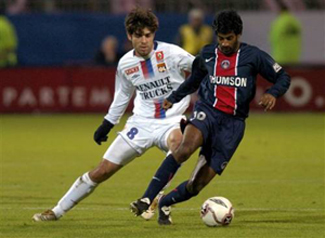
Vikash Dhorasoo sait d’où il vient. Ses arrière-grands-parents, qui appartenaient à l’ethnie des Télégou, ont quitté l’Inde et l’Etat d’Andra Pradesh pour couper la canne à sucre à l’île Maurice. " C’était l’époque où les colons venaient chercher de la main-d’ouvre, bien avant le tourisme ", lâche-t-il, plein de sous-entendus. Ses parents sont hindous, parlent hindi et créole, lui est athée et prétend faire savoir que " Le Havre n’est pas une ville si moche que ça " et que les gens y sont " très chaleureux ". Bien sûr, il est issu d’un " quartier chaud ", comme il dit, affirme connaître les raisons de la " violence des jeunes " et raconte souvent ce jour où quatre policiers l’ont conduit, à cause de sa mine plutôt mate, dans un parking pour une fouille en règle avant de s’apercevoir qu’il s’agissait de Dhorasoo et, donc, d’une " méprise ". " Ce jour-là, j’ai compris que je n’étais plus le fils d’immigré noir, mais un footballeur qui gagnait de l’argent. "
Aujourd’hui, son salaire avoisine les 300 000 francs. Un futur transfert s’évaluerait autour de 30 millions de francs. A l’intersaison, Vikash - " progrès et prospérité " - a eu le choix entre Bordeaux et Lyon, plus quelques offres venues d’Espagne et d’Angleterre. " Je ne voulais pas quitter la France, avoue-t-il. Déjà, la séparation d’avec ma famille restée au Havre n’a pas été simple à gérer, alors je ne me voyais pas mettre plus de distance encore. " Il a signé à Lyon parce que " Bordeaux me faisait évoluer à un autre poste ". Lui, ce qu’il aime, c’est jouer juste derrière les attaquants, plutôt dans l’axe. Orienter le jeu, faire reluire sa technique toute en finesse, ses changements d’orientation servis par un centre de gravité assez bas (il mesure 1,68 m, soit un centimètre de moins que Lizarazu).
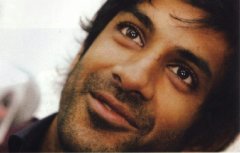 Et le voilà dans le groupe France, là où Roger Lemerre clame qu’il se trouve " peut-être dans la situation idéale pour débuter " avec les Bleus. Mais du forfait de Zidane contre l’Ukraine, Dhorasoo retire d’abord une frustration : " Je n’ai jamais joué avec lui, ni même effectué des entraînements à ses côtés. Ça doit être un régal. " Il dit sans fausse modestie que l’opportunité qui s’offre à lui avec l’équipe de France ne consiste pas à prendre la place au meilleur numéro 10 du monde mais à offrir une éventuelle complémentarité. Une association du type Platini-Giresse des années quatre-vingt, par exemple. Toujours est-il que Vikash Dhorasoo a franchi les grilles du Centre technique national avec une certaine appréhension.
Et le voilà dans le groupe France, là où Roger Lemerre clame qu’il se trouve " peut-être dans la situation idéale pour débuter " avec les Bleus. Mais du forfait de Zidane contre l’Ukraine, Dhorasoo retire d’abord une frustration : " Je n’ai jamais joué avec lui, ni même effectué des entraînements à ses côtés. Ça doit être un régal. " Il dit sans fausse modestie que l’opportunité qui s’offre à lui avec l’équipe de France ne consiste pas à prendre la place au meilleur numéro 10 du monde mais à offrir une éventuelle complémentarité. Une association du type Platini-Giresse des années quatre-vingt, par exemple. Toujours est-il que Vikash Dhorasoo a franchi les grilles du Centre technique national avec une certaine appréhension.
" J’avais un peu peur de me retrouver à la table des champions du monde, admet-il. Je craignais de déranger et en fait j’ai été très bien accueilli. " Il connaissait du monde à l’intérieur. D’abord Roger Lemerre, qui fut son entraîneur au bataillon de Joinville lors de son service national et avec lequel il est devenu champion du monde militaire en 1995. Ensuite les joueurs qui furent du voyage olympique à Atlanta l’année suivante : Wiltord, dont il partage la chambre à Clairefontaine, Pires, Vieira. Vikash affirme être déjà " intégré " au sein des Bleus et espère maintenant fouler " pour la première fois " la pelouse où les Tricolores sont devenus champions du monde en juillet dernier. Il interroge dans un clin d’oil : " Passer en huit mois du stade Jules-Deschaseaux (l’enceinte du Havre Athletic Club, NDLR) au Stade de France, c’est un beau voyage, non ? "
Laurent Chasteaux
Courtesy: l'Humanite
He bears a name that many in India would identify with, but plays football with the elite of the world. He is Vikash Dhorasoo — the first player of Indian origin all set to play in the 2006 World Cup. Dhorasoo, who earned fame as an accomplished midfielder playing for different European clubs including AC Milan, has been named a member of Equipe Tricolore — the French national team — for the 2006 World Cup. He is set to play alongside the likes of Zinedine Zidane and Thierry Henry as the former World Cup champion launches its campaign in Germany on June 9.
Dhorasoo spoke about his childhood, his career as a professional football player and his plans exclusively through e-mail when Sportstar contacted him in Paris.
His views, laced with irony and wit, reflect his enigmatic personality. However, he is clear about one thing — his love for India, the land of his forefathers. Dhorasoo's ancestral roots are in Andhra Pradesh. He says he would be coming to India, not as a tourist but with concrete plans for developing the sport in the country.
Dhorasoo's career as a professional is impressive. He is currently with FC Paris Saint-Germain in French Ligue 1. A man of strong tastes and preferences, he fell out occasionally with previous club and national team coaches, which delayed his selection to the French squad.
France's coach Raymond Domenech, however, found in him a worthy midfielder and chose him for the national squad. Dhorasoo, who has represented the French under-21 and under-23 teams, played in the Olympic finals in Atlanta in 1996.
Earning a place in Equipe Tricolore, according to Dhorasoo, is the brightest moment of his career.
Excerpts:
Question: Who inspired you to take up football as a profession?
Answer: Everybody in my family inspired me to take up football. My father and my uncle played club football in Mauritius. In France, we were always watching football on television. I've got pictures of me as a toddler holding a football. The love for the sport runs in the family. It's also the national sport in Mauritius.
At what age did you start playing?
I got into systematic training late when I joined a local club at the age of nine, which is quite late in Europe. Like a lot of kids, I mostly played on the yard in front of my building.
Can you tell us something about your childhood?
Well, there is nothing exceptional. I spent my childhood in the suburbs of the harbour Le Havre, in Normandy. I lived in a poor neighbourhood called Caucriauville, but I can't complain. It's like the childhood of a lot of young French boys — going to the school and playing football in front of our building. I started football in a club rather late. I wasn't an intern at "formation centres" like a lot of my colleagues. I managed to have a regular scholarship, like my brother and my two sisters. Studies were important in my family. In all, I had a regular childhood.
Who helped you in growing up as a world-class footballer?
All the people you meet in your life give you something, whether you like them or not. I met a lot of people — some important and some not so important — but I learnt something from all of them. It's not my style to thank somebody or someone.
How was the path to graduation as a French national team player? Do you think you could have made it to the team a lot earlier?
I had to be in it sooner or later. In the end, I find all the fuss about who's in and who's not in, very insignificant. Most of us are in that state of uncertainty — where we come and then disappear from the team and then make a comeback. It's funny that I came back so late. There were times when I thought I was lost for the national team! My elevation to the national squad was not just Raymond Domenech's choice. It's more about my personality than my performances. And that has prompted him to choose me.
There were reports about you getting involved in disputes with national coaches and team-mates. What actually happened?
You know, I sometimes get involved in disputes with my parents, or my brother and sisters. That's not very important.
How is your life after you got a chance to play for the French national team?
The national team belongs to the French people. It means representing the best of our country. The selection story may be very important to the media. I feel it happened naturally as I was then playing in Paris. All that explains how I came under the spotlight. When I got to play for France first I was surprised because at the time I was leaving for Milan (2004). I was supposed to have faded away from France but I got selected for the French team. That brought me enough popularity. I find all this quite paradoxical.
You are used as a replacement in the slot dominated by a star like Zidane. Do you feel the extra pressure because of that?
Yes, of course, but again, most of the pressure comes from just representing the team. It's a great team, and with it carries greater expectations from the whole country. But it's also a pleasure playing with Zidane.
Do you think the modern system of football has enough scope for creative players like you?
Yes, of course. There's room for everybody. I don't know if I'm a creative player, but there's room for the small ones, the big ones, the Indians...
You are now a senior in club football and have represented many clubs in and out of your country. Which club did you love playing in the most and why?
Well, the club I liked the most was AC Milan, but I didn't play a lot there. It was an incredible club, I would need the whole day to tell you what I was experiencing up there. Even when I finish telling you about the experiences, you would find it difficult believing me. I guess you have to be there to understand it.
What is the toughest challenge you have faced as a footballer?
Probably trying to become a regular in Milan. I had to fight my way and make a place where the likes of Kaka, Pirlo, Gattuso, Seedorf were unquestionable and playing really well.
How do you cope with the physical challenge from the big-sized Europeans or Africans? How important is it to be physically robust to survive in football at the world level?
There are more and more athletes in football. But I'm not really an athlete. So, yes, it's difficult, but it's not impossible. But when I see players like Giuly, Iniesta in FC Barcelona, they're small-sized players. There's only one solution: you have to thread and avoid the big players and not run into them.
What is your idea about India? Have you ever come to India?
I haven't been to India as yet. I know where I come from. My great grand parents come from India, Andhra Pradesh, more precisely. From there they came to work in the sugarcane plantations of Mauritius, nearly as slaves. Some of my family members have already gone to India, to see how our country of origin is. I know I'll go there later with my family as well. But it's a journey that needs preparation and time too.
I don't want to go to India as a tourist. I have a real interest in that country. I know India through its movies, its music, its dances, and its food. That's the India I know.
Do you know any club in India? If any Indian club invites you, would you like to play here?
No, I don't know them. Maybe, I'll come at the end of my career. It would be great fun if I were able to work with the Indians in India.
You will be treated as an icon in the country of your origin. Would you like to come to India and inspire the young generation in taking up the sport?
I believe many Indian people are not very attracted to football. It seems to be ingrained very deep somewhere! Well, there's some work to be done to revive the interest about football among the Indian people. I don't know where they are positioned in the world order right now, but the country can really come up. If I can help in the reconstruction process, I would be glad!
You reportedly have interest in fine arts and literature. Do you love to be called an `intellectual footballer'?
I find that quite ridiculous! It's not very nice for the other footballers. They're not all idiots! And it's not very nice to the intellectuals either. You know, when I arrived in Lyon, I went to the opera because it was the first time I was in a city with an opera. I wanted to see how it was. A journalist saw me there and the next day, there was a story in the press about me being a great opera fan. That was nonsense — it was the first time I had ever been to an opera!
Please tell us about your life outside football.
Just a normal life, taking care of my wife and kids... I'm just a normal guy.
 France's first game in the FIFA World Cup Soccer 2006 with Switzerland: Vikash Dhorasoo came in the 82nd minute and almost scored an exciting goal - a sizzling shot from range which just missed the far post. It was probably the only hopeful moment from the otherwise uninspiring match it was till then.
France's first game in the FIFA World Cup Soccer 2006 with Switzerland: Vikash Dhorasoo came in the 82nd minute and almost scored an exciting goal - a sizzling shot from range which just missed the far post. It was probably the only hopeful moment from the otherwise uninspiring match it was till then.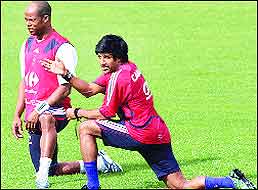 PUNE, JUNE 18:They aren’t celebrating in Vishakhapatnam yet but maybe they will in a few weeks, when Vikash Dhorasoo’s international career finally gets set to take off. The French midfielder has so long lived in the shadows of Zinedine Zidane—they play the same role for the French team—but Zizou’s retirement after the World Cup opens the way for him.
PUNE, JUNE 18:They aren’t celebrating in Vishakhapatnam yet but maybe they will in a few weeks, when Vikash Dhorasoo’s international career finally gets set to take off. The French midfielder has so long lived in the shadows of Zinedine Zidane—they play the same role for the French team—but Zizou’s retirement after the World Cup opens the way for him.
In fact, he’s already created history, becoming the first footballer of Indian origin to play at this level by turning out against Switzerland last week. ‘‘He told me it was a very special feeling,’’ his mother Nalinee told The Indian Express from Paris, where the family lives.
Though Dhorasoo himself has never spoken too emphatically about his Indian roots, saying only that he would like to go to India but ‘‘not as a tourist,’’ his mother had no such qualms. ‘‘We originally come from V-sha-ka-pat-nam,’’ she said, spelling out the word with a heavy French accent. ‘‘My grandparents lived in Andhra Pradesh.’’ They were taken to Mauritius to work on the sugar plantations, and that’s where Nalinee met Vikash’s father Manduth who worked as a plumber on the Britannia Sugar Estate.
The family moved to France in 1970, where Vikash was born three years later. His childhood was spent in Le Havre, Normandy, and he grew up in a neighbourhood called Caucriauville where he learnt the sport on the spaces available between buildings. ‘‘He was, I think, about nine when he went to play organised football, though studies was equally important,’’ Nalinee said.
His steady rise through the ranks, with Lyon, Bordeaux, AC Milan and now Paris St-Germain, not only brought him to national attention but also dispelled the notion that Indians are genetically not predisposed to football at the top levels.
‘‘He is a good boy,’’ says legendary French coach Guy Roux. ‘‘His technique is very good, his passing is beautiful. Not that good in defence but his attacking skills are good.’’
Roux was coach at Auxerre for 44 years before retiring last July, taking the club from the regional Burgundy league to being French champions and his famous academy producing stars such as Eric Cantona and Djibril Cisse. Dhorasoo might have been another. ‘‘He was in my office in Auxerre as a young boy,’’ Roux said. ‘‘He spent two hours with me. We tried to sign him but he didn’t join.’’
What does he see in Dhorasoo’s future? ‘‘Unfortunately, I don’t think he’ll play that long for France because he’s 32; if he was 22, that would be different, he would have a long international career ahead of him.’’ Was he unlucky in being around the same time as Zidane? ‘‘Perhaps,’’ he says with a shrug.
Was football on his mind right through? ‘‘It’s in the family... his father’s side. In fact, both his father and uncle played football.’’ While Manduth played a role in shaping his football career, perhaps the greater influence came from his maternal uncle, Sama Sanassee. Speaking from Port Louis, Mauritius, Sama sought to downplay his contribution. “Ah! I was no professional like Vikash, you know. I played for a village called Lasalines in Port Louis as a youngster, nothing more.”
Yet Dhorasoo’s World Cup debut against Switzerland last week was celebrated in Mauritius (and, on the Net, by Telugus and Mauritians everywhere).
‘‘He made us all proud,’’ said Vanishree, Sama’s daughter. ‘‘We knew he was talented since he was associated with big clubs, it was only a question of when he would hold centrestage. A debut—even if for a limited period—in the World Cup almost makes us feel like we are part of Vikash’s biggest dream.’’
Has she spoken to him? ‘‘No, I haven’t but my dad (Sama) spoke to his dad (Manduth). They congratulated each other, after all it was a family thing, you know.’’
Vikash last visited Mauritius two years ago, Sama recalls. ‘‘It was a time when most of us Sanassees got together.”
Was he interested in his roots? ‘‘The interest to know his family roots is a common feature in these reunions,’’ Sama says.
So what is Vikash: French, Mauritian or Indian? “Vikash was born in France,” Sama begins.
‘‘He’s married a French girl,’’ he says after a pause. ‘‘It’s like his mother (Nalinee) who hails from an Indian family... all of us speak and understand Telugu, but were born in Mauritius.”
In football’s flat world, perhaps it really doesn’t matter.
micky.aigner@expressindia.com
Event organised by `Impressions' attracts many
TIRUPATI: A popular collection of paintings sketched by noted artist and film director బాపు (Bapu) are on display at Balaji Bhavan exhibition hall here.
The exhibition is conducted by `Impressions', a Vijayawada-based art promoter for the first time in Tirupati and needless to say, the `Bapu' tag has attracted a number of visitors on the first day itself.
Bapu's inimitable style of expressing his ideas with suavity and subtlety is the hallmark of the paintings.
Fancy for details
Many of his works on display revolve around Krishna, showing him as a lovable child, as a romantic lover of `Gopikas' and as a statesman in the battlefield.
The finesse of Telugu art is reflected in every inch of the canvas.
The 6ft X 1ft wooden panel depicting Ramayana in a nutshell stands as yet another highlight of the artist's deep knowledge of the epic and his fancy for details.
There are books on Mahabharata with paintings by Bapu and narration by his associate Mullapudi Venkataramana.
Budugu's show
బుడుగు (Budugu), the character of a naughty boy created by Bapu drawing inspiration from Dennis the Menace, has a gallery of his own.
In fact, there are a number of mementoes in the form of books, laminated photos and porcelain mugs depicting Budugu and girlfriend 'Seegyanapesuna' (read 'Sri Gnana Prasuna').
The expo, which is a `must watch' for all art lovers, closes on Sunday.
Courtesy: The Hindu
Event organised by `Impressions' attracts many
TIRUPATI: A popular collection of paintings sketched by noted artist and film director బాపు (Bapu) are on display at Balaji Bhavan exhibition hall here.
The exhibition is conducted by `Impressions', a Vijayawada-based art promoter for the first time in Tirupati and needless to say, the `Bapu' tag has attracted a number of visitors on the first day itself.
Bapu's inimitable style of expressing his ideas with suavity and subtlety is the hallmark of the paintings.
Fancy for details
Many of his works on display revolve around Krishna, showing him as a lovable child, as a romantic lover of `Gopikas' and as a statesman in the battlefield.
The finesse of Telugu art is reflected in every inch of the canvas.
The 6ft X 1ft wooden panel depicting Ramayana in a nutshell stands as yet another highlight of the artist's deep knowledge of the epic and his fancy for details.
There are books on Mahabharata with paintings by Bapu and narration by his associate Mullapudi Venkataramana.
Budugu's show
బుడుగు (Budugu), the character of a naughty boy created by Bapu drawing inspiration from Dennis the Menace, has a gallery of his own.
In fact, there are a number of mementoes in the form of books, laminated photos and porcelain mugs depicting Budugu and girlfriend 'Seegyanapesuna' (read 'Sri Gnana Prasuna').
The expo, which is a `must watch' for all art lovers, closes on Sunday.
Courtesy: The Hindu
 click on image
click on imageHYDERABAD — The first semiconductor or silicon chip manufacturing unit of India is expected to be ready in a year's time, setting in motion of the process of making India self-sufficient in the crucial area of high tech and electronic hardware industry.
Foundation stone was laid in Hyderabad yesterday for $3 billion "FAB City" project, promoted by the US-based SemIndia.
Speaking on the occasion Indian Minister for Communication and Information Technology Dayanidhi Maran said that government will come out with a new policy and special package of incentives for semiconductor manufacturing in the country with in a few weeks to give a boost to the high-tech and electronic hardware industry.
Maran said that without a semiconductor-manufacturing base, India will not be able to emerge as a major hub of hardware manufacturing.
The first phase the FAB City will have an assembly and testing plant with an investment of $100 million. It is expected to be ready with in a year. Subsequently about six Fabs or the semiconductor and chip-manufacturing units will be built with an investment of 3 billion dollars in two phases.
The entire project will be spread over an area of 1,200 acres at Tukkuguda in Ranga Reddy district. The foundation stone plaque was formally unveiled by the State Chief Minister Y. S. Rajasekhara Reddy.
Dayanidhi Maran said that the FAB City will definitely be a Special Economic Zone to make it more viable and workable. "It is not for domestic consumption alone. It is also for exports to ensure that we utilise it fully by exporting to the neighbouring countries," he said.
Quoting the recent study by Frost and Sullivan, Maran said that the demand for electronic consumption would touch $ 350 billion by 2015 and India would have to import semiconductors of $ 40 billion worth. He said that the Fab City project will help in substituting the imports with the locally manufactured semiconductors and it will bring down the cost by 15 per cent.
He said more and more companies were looking at India seriously for the semiconductor manufacturing as it gives them cost advantage also offers a very big market.
"This is why we are taking active steps in establishing core component supply to the emerging electronic manufacturing services companies such as Nokia, Motorola, LG, Flextronics and Solectron etc," he said.
Pointing out that semiconductor industry was very capital intensive and other countries had taken equity participation and given incentives to the industry, Maran said that before drafting the policy Indian government also had to look at what countries like USA, China, Taiwan, Singapore, Malaysia, Germany and Ireland had done and how they had funded the industry.
Vinod Kumar Agarwal, the Chairman and CEO of SemIndia announced strategic partnership with Base Oxygen Corporation (BOC) for providing infrastructure and equipment facilities, gases and vaccum products and services to the FAB City project.
After signing a formal MoU, Sanjiv Lamba, the managing director, South and South East Asia, BOC said that the company will be investing Rs120 crore (approximately $27 million) for each FAB unit of SemIndia in Hyderabad.
The SemIndia has already announced strategic partnerships with Flextronics of Singapore and AMD of the USA. Surbana International of Singapore will develop the Master Plan and township development study for the FAB City project.
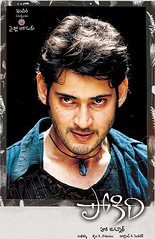 But I guess it is time for this to be corrected. Mahesh Babu's పోకిరి (Pokiri) is a box-office sensation in Chennai, and has consistently been among the top for quite some weeks now.
But I guess it is time for this to be corrected. Mahesh Babu's పోకిరి (Pokiri) is a box-office sensation in Chennai, and has consistently been among the top for quite some weeks now.
 హైదరాబాద్, జూన్ 4 (ఆన్లైన్): ప్రముఖ భాషావేత్త బూదరాజు రాధాకృష్ణ ఆదివారం కన్నుమూశారు. కొంతకాలంగా అస్వస్థతతో బాధపడుతున్న ఆయన హైదరాబాద్ కళ్యాణనగర్లోని తన సొంత ఇంటిలో ఆదివారం మధ్యాహ్నం 2.30 గంటలకు మరణించారు. 75 ఏళ్ల బూదరాజు రాధాకృష్ణ భాషావేత్తగా, వ్యాకరణవేత్తగా, కవిగా, కాలమిస్టుగా, జర్నలిస్టులకు గురువుగా సుప్రసిద్ధులు. ఈనాడు దినపత్రికలో సుదీర్ఘకాలంపాటు 'సి. ధర్మారావు' పేరుతో 'పుణ్యభూమి' కాలమ్ను నిర్వహించిన ఆయన ప్రస్తుతం మనభూమి మాసపత్రికకు 'ధర్మస్థలి' కాలమ్లో వ్యాసాలు రాస్తున్నారు. ప్రకాశం జిల్లా వేటపాలెంలో 1932 మే 3న సువర్చల, నరసింహారావు దంపతులకు బూదరాజు రాధాకృష్ణ జన్మించారు. తెలుగు అధ్యాపకులుగా వృత్తిజీవితాన్ని ప్రారంభించిన రాధాకృష్ణ అనంతరం తెలుగు అకాడమీలో భాషావేత్తగా 20 ఏళ్లపాటు పనిచేశారు.
హైదరాబాద్, జూన్ 4 (ఆన్లైన్): ప్రముఖ భాషావేత్త బూదరాజు రాధాకృష్ణ ఆదివారం కన్నుమూశారు. కొంతకాలంగా అస్వస్థతతో బాధపడుతున్న ఆయన హైదరాబాద్ కళ్యాణనగర్లోని తన సొంత ఇంటిలో ఆదివారం మధ్యాహ్నం 2.30 గంటలకు మరణించారు. 75 ఏళ్ల బూదరాజు రాధాకృష్ణ భాషావేత్తగా, వ్యాకరణవేత్తగా, కవిగా, కాలమిస్టుగా, జర్నలిస్టులకు గురువుగా సుప్రసిద్ధులు. ఈనాడు దినపత్రికలో సుదీర్ఘకాలంపాటు 'సి. ధర్మారావు' పేరుతో 'పుణ్యభూమి' కాలమ్ను నిర్వహించిన ఆయన ప్రస్తుతం మనభూమి మాసపత్రికకు 'ధర్మస్థలి' కాలమ్లో వ్యాసాలు రాస్తున్నారు. ప్రకాశం జిల్లా వేటపాలెంలో 1932 మే 3న సువర్చల, నరసింహారావు దంపతులకు బూదరాజు రాధాకృష్ణ జన్మించారు. తెలుగు అధ్యాపకులుగా వృత్తిజీవితాన్ని ప్రారంభించిన రాధాకృష్ణ అనంతరం తెలుగు అకాడమీలో భాషావేత్తగా 20 ఏళ్లపాటు పనిచేశారు.Buddaraju was suffering from respiratory ailments. He was born in Vetapalem in 1932. He achieved PhD from Andhra Viswa Kalasala Parishad in 1965 by writing historical essay on ancient Telugu language.
For 15 years he worked as Telugu lecturer and for another 20 years he worked as Telugu Academy Research head. He retired in 1988. He has written articles in Eenadu in the name of Punyabhoomi with the alias of Dharma Rao.
He was appointed as the head of Eenadu Journalism College principal and worked for a decade creating many journalists. He has written more than 50 books and proved his skills in Telugu and Sanskrit and increased the quality in newspaper language. He researched on the different accents of Telugu language.
He has faced many problems due to his self reliance and uncompromising nature. Chief Minister Y.S. Rajashekhar Reddy, opposition leader N. Chandra Babu Naidu and Eenadu chief editor Ramoji Rao expressed their deepest condolences for the demise of Budaraju Radhakrishna.
Courtesy: AndhraCafe

